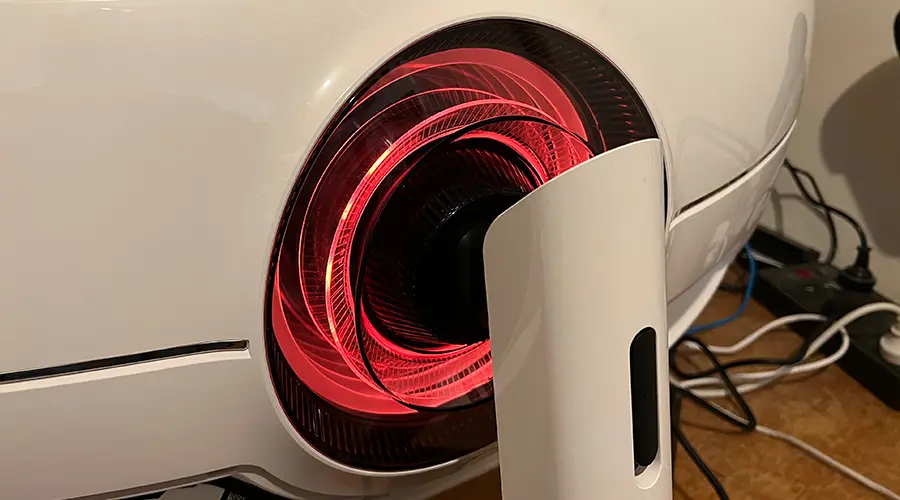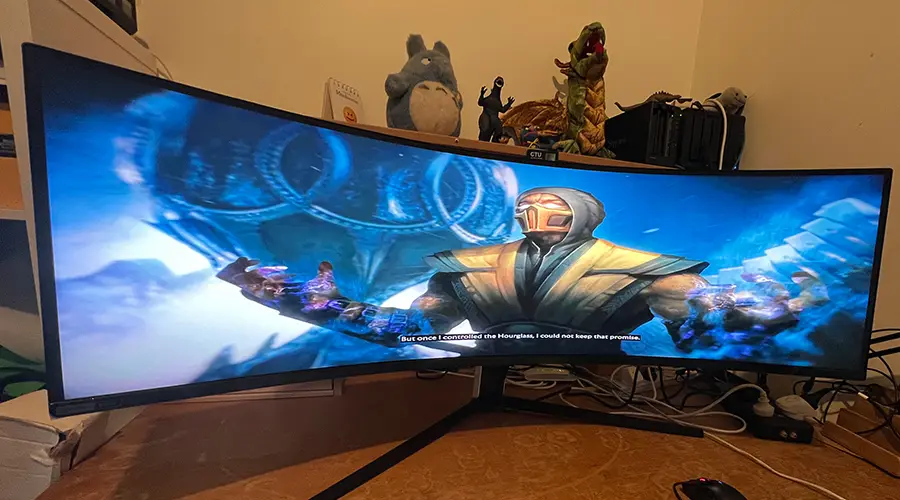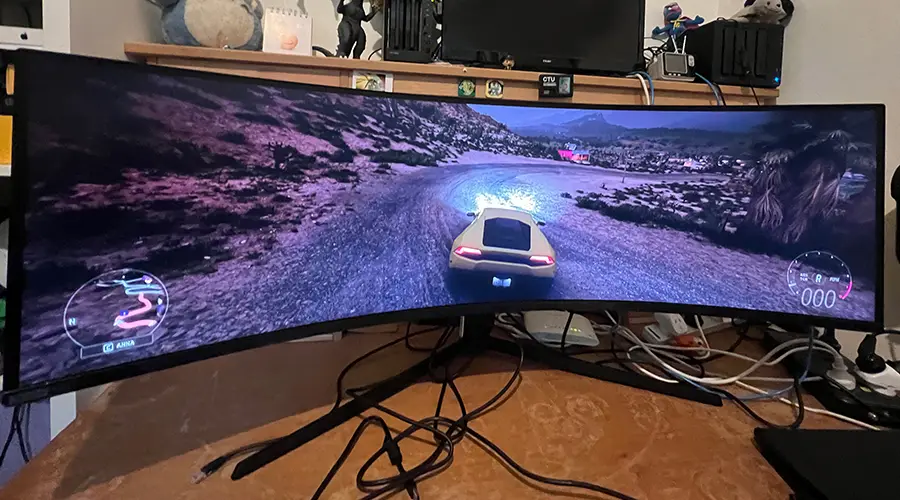Samsung Odyssey G9 review: Fun, ludicrous… but maybe not that practical

Summary
Quick verdict: The Samsung Odyssey G9 is an astonishing monitor. You'll be amazed by the size, intrigued by the curve and left more than a little bit less well off if you buy one. It's best suited for serious gamers, especially those who play fast driving games, and less suitable for everyday productivity work despite its super-wide display.
- Incredibly immersive for gaming
- Looks like the love child of Tron and Portal
- Excellent colour and responsiveness
- Incredibly expensive
- It's HUGE. Possibly beyond HUGE
- Why doesn't it have speakers?
Curved gaming monitors are nothing new. Makers will argue that a curved display adds immersion that you just don't get from a flat display. However, that only extends as far as your eyesight, which means most regular desktop curved gaming monitors fall away the moment your gaze wanders to their sides. The Samsung Odyssey G9 does not have this problem.
Well, unless your eyeballs have removed themselves entirely from their sockets. It's an almost ridiculously large curved gaming monitor that demands attention – and an extra-large desk to place it upon.
Design: Think of a big screen. Now think of a bigger one. Go up from there…

Image: Alex Kidman
The Samsung Odyssey G9 is, at a technical level, a 49-inch monitor. In TV terms, that would place it as a small display, but we're talking here about a screen designed to fit onto a desk, sitting much closer to your eyes than a regular TV typically does.
That's presuming that you have a desk that can accommodate the Samsung Odyssey G9 because the reality of a 49-inch curved monitor is that it's just plain huge. Enormous, gigantic, immense – you might think you're getting the picture thanks to my thesaurus deep dive, but it's really a display that doesn't quite make its impact until you're in front of it.
I could tell you that it's 1147.6x537.2x416.4mm and you'd probably think, "OK, those are some large numbers".
I could say it's 16.7kg with its stand locked in place, and you'd probably appreciate that it's also heavy.
However, what you might not think of is that you will need a very large and stable desk to place it on. I only have one desk in my entire house that was suitable. Setting up the Samsung Odyssey G9 meant that I had to clean it before there was even space for that. That's probably a plus for me having a tidier office, but if you're working off a smaller or lighter desk, forget it.

Image: Alex Kidman
Set up of a monitor of this size is a whole process in itself. Samsung recommends that you do the set-up process within the large box it ships in for the most part, stripping away covering plastics and bolting on the stand before lifting it out of the box. Samsung's instructions are pictograms, and they could be a little clearer. It's not always evident where one part is removing protective plastic or where another might be clipping something into place.
The Samsung Odyssey G9 comes with a stand and rear cover designed to hide away your connection cables, which is great if you want it to be stylish and discrete. However, if you're using it as a multi-monitor solution via its HDMI and DisplayPort connections, you're going to struggle to get everything to fit. I gave up in the end and just left the rear panel exposed with trailing cables. That also makes it much easier to access its dual USB ports if you need them.

Image: Alex Kidman
Surprisingly, the Samsung Odyssey G9 is capable of being wall or monitor-arm mounted, but again, you'd want to invest in a really serious monitor arm and make sure your wall mount was well secured for this to work. You'd also need a desk the size of Western Australia to swing the Samsung Odyssey G9 in and out of usable distance.
One feature I was surprised to see omitted from the Samsung Odyssey G9 was any kind of inbuilt speakers. At this price, and given Samsung can put reasonable sound into some very thin QLED TVs these days, it would seem like an obvious inclusion. As it is, you'll need headphones or even more desk space to accommodate speakers for your gaming audio.
The front of the Samsung Odyssey G9 is dominated by its 49-inch display, while the rear evokes a somewhat 1970's sci-fi aesthetic, with an RGB glowing light that you can optionally have projecting from the rear. It's a very cool look, if a little on the evil side.
Let's put it this way – when I build my evil genius volcano lair, my receptionist is going to have a Samsung Odyssey G9 at the front desk with an angry glowing light at the back, just so you're not sure if they're about to zap you simply for approaching.

Image: Alex Kidman
Controls on the Samsung Odyssey G9 are handled by a traditional nub joystick located at the bottom right of the display. Kudos to Samsung here for presenting a clear and easy-to-understand menu that makes it very easy to tweak settings to your personal preference.
Samsung Odyssey G9 review: The performance is fantastic for gaming but middling for everyday use

Image: Alex Kidman
At a technical level, the Samsung Odyssey G9 is a 49-inch QLED panel with a 5120x1440 pixel resolution and support for 1ms response time, 240Hz refresh rates and both G-Sync and FreeSync 2 from compatible PCs. At a connection level, it features dual DisplayPort connectors and a single HDMI socket, and you can indeed use picture-in-picture modes to show off 2 systems at once if that's your style.
The key curved metric here is a radius of 1,000mm, which means that it's very curved indeed. At typical sitting distance from a monitor, you really do have to turn your head sharply to not be looking at the Samsung Odyssey G9.
That 240Hz refresh rate should be a bit of a headliner, but there's a challenge here for many PCs because shifting that kind of resolution at that rate is beyond the scope of all but the most cutting edge graphics cards. Samsung uses Display Stream Compression (DSC) via DisplayPort to meet the needs of the Odyssey G9's super-wide display and refresh rates, but only if you're packing a card with inbuilt DSC support.
Without it, you'll be playing in 120Hz city over DisplayPort, or just 60Hz over HDMI. If you're spending the kind of cash Samsung wants for the Samsung Odyssey G9, it would feel a tad underwhelming not to be able to push it as far as possible – presuming what you're doing with the Samsung Odyssey G9 supports it in the first place.

Image: Alex Kidman
There's little doubt that the Samsung Odyssey G9 is first and foremost a gaming monitor, so testing it out was an arduous process of playing a lot of games while assuring everyone around me that I was "working".
Which I was, because in many cases, getting games to play as nicely as possible with the Samsung Odyssey G9 can be a bit more work than you'd expect. Some games won't happily jump to the effective 32:9 aspect ratio of the Samsung Odyssey G9. Some will letterbox or sidebar, and it can become a game of hunting around the Internet for fan-made hacks to enable PC games to make the most out of a very wide display like this.
The Samsung Odyssey G9 is rather resolutely a PC-only monitor. I experimentally hooked up an M1 MacBook Pro to the Samsung Odyssey G9, and while it would display, it struggled with the resolution to deliver a clean and pleasing image. It'll work if it has to… but you really shouldn't.

Image: Alex Kidman
The other challenge with the Samsung Odyssey G9 pertains to the kinds of games you play and how you like to play them. The immersion factor of the Samsung Odyssey G9 can't be overstated because it's quite amazing when you sit in front of it for specific game types.
Racing games are quite superb because that wide display really does draw you into the world you're speeding through. I tested with Forza Horizon 5, and it's the first time I've been particularly tempted to play with the in-car view in play. It's practical to do so this way, and the geometry of drawing and speed fairly closely matches that which you'd expect while driving. Matching the Samsung Odyssey G9 up with a good PC driving wheel would be an intense experience.
FPS gaming can be good, but you've got a few issues to contend with beyond support for faster frame rates and screen ratios at this size. Most FPS games shift quickly between moving and waiting periods as part of their gameplay loops. When you're waiting, depending on the game's set field of vision, you may find some very quirky geometry going on at the sides thanks to that 1000R curve.
The same is very true for any flat 2D game or even games with a 2D-style aesthetic. I briefly played a little Mortal Kombat 11 on the Samsung Odyssey G9, but it was quite off-putting. Not because of the gore, but simply because that resolution and curve render rather squat, chunky fighters where they're usually shredding gallons out of each other in slick athletic bodies.

Image: Alex Kidman
In theory, the Samsung Odyssey G9 could also do good work as an actual productivity machine, replacing the need for a multi-monitor array with just one fancy panel. It very much again depends on the kinds of work you need to do. It's easy enough to set up (for example) for multiple web browser tabs at once if you've got to monitor or research information, although the wider nature of the display means you do move your neck a little more to see everything over time.
If you're working with photos or video, it's much less compelling because that curve introduces warping into images that you can't unsee, but won't be apparent on anyone else's display. I experimentally used the Samsung Odyssey G9 to record an episode of my podcast and while I could work across the Samsung Odyssey G9, it was actually more distracting than my usual multi-monitor set-up. This was simply because of tools that didn't quite render the way that I'd expect on a flat-screen display. You could get around that by only working on documents directly in front of your eyes where the curve is the least – but why would you buy a 49-inch curved monitor to not use all of its display?
Should you buy it?
- Buy it if you can afford it, place it safely and game a lot.
- Don't buy it if you want a productivity monitor or don't want to tinker with settings.
The sheer sticker price of the Samsung Odyssey G9 acts as a gateway for most buyers. If you can't stump up Samsung's $2,499 asking price, you're out of the picture entirely.
But even if you can, is it worth it?
You're certainly getting a lot of monitor, and you will need plenty of space to accommodate it. General picture quality with a fully firmware updated display was very good for specific games in my tests, but a little less so across the board. For games, that could be a matter of tweaking settings for monitor, computer display and specific titles. For productivity work, it's a much harder sell because you could buy a flat-panel display with a technically larger – but not curved and wide – display for this kind of price.
The Samsung Odyssey G9 is an absolute niche product. I love its scope, and there's simply nothing like it for tearing through virtual raceways or obliterating aliens on a regular basis, but its pricing and size are going to be issues for all but the most cashed-up gamers.

Image: Alex Kidman
Samsung Odyssey G9 review: Pricing and availability

Specifications
Specs
Features
How we tested
The Samsung Odyssey G9 was loaned to me by Samsung for the purposes of review. The Samsung Odyssey G9 was carefully unpacked (did I mention it weighs a lot?) and tested over 2 weeks, primarily using it for gaming purposes to assess its suitability within that space. I also tested it as a daily-use monitor for my writing, video production and podcast work connected to a desktop PC, gaming laptop and MacBook Pro. The author has been writing about PCs, gaming and components since 1998 with extensive reviewing experience.
